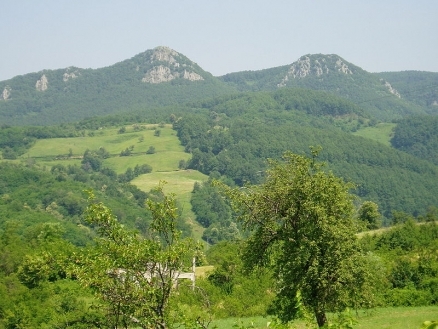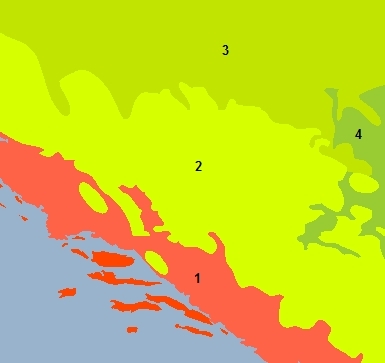Ecoregions of Bosnia and Herzegovina
Ecoregions of Countries Collection 
Bosnia and Herzegovina has four ecoregions
- Illyrian deciduous forests
- Dinaric Mountains mixed forests
- Pannonian mixed forests
- Balkan mixed forests
Contents
Illyrian deciduous forests
Illyrian deciduous forests encompass coastal areas on the eastern coast of the Adriatic Sea. This ecoregion is actually comprised of three distinct forest types, two of which are broadleaf and one of which is a mixed conifer/broadleaf Plant community. The region has a relatively high floral endemism rate with many relict and narrow range species. Faunal diversity is high, and a number of IBAs (Important Bird Areas) and threatened SPECs (Species of European Concern) are found within the region. Illegal logging, illegal hunting, and uncontrolled plantharvesting have destroyed extensive forest areasthat have been relatively intact until recently.
Overexploitation of forests is ongoing in certain areas due to the political instability of most countries in the ecoregion. Additinally the coastal aspects of the region are a present attractant to the tourism industry, and significant amounts of tourism infrastructure and urbanisation are ongoing in the region from these drivers.
Dinaric Mountains mixed forests
The Dinaric Mountain mixed forests ecoregion encompasses the northwest-southeast Balkan mountain ranges, from the eastern Alps to the northern Albania massifs. The Dinaric Mountain range spans several countries of Eastern Europe and is covered by mixed forest with an outstanding variety of deciduous oak trees. These forests are among the largest and most continuous tracts of forested habitat remaining for large carnivores in Europe. The flora has a relatively high endemism rate with many relict and restricted range species. Faunal diversity is high, and a number of IBAs (Important Bird Areas) and threatened SPECs (Species of European Concern) are encompassed within the region. Human impact remains high in this ecoregion, mainly due to the socio-economic and political instability of most countries in the region, where illegal logging, illegal hunting, and uncontrolled plant harvesting have recently destroyed extensive forest areas that had remained virtually untouched until current times.
The mountain ranges of this region have had low human populations, and tall forests still prevail widely throughout. A significant number of pristine large forest stands remained quite untouched until very recently. Rapid and intense forest degradation in the form of illegal logging, pollution, and fire took place during the recent Balkan conflicts that led to the division of the Former Yugoslavia into a number of independent republics. Overexploitation of forests is ongoing in certain areas due to the political instability of most countries in the ecoregion.
Pannonian mixed forests
This ecoregion consists of the depression surrounded by the Carpathian Mountains, Alps, and Dinaric Mountains. Avifauna diversity is high; there are fifty Important Bird Areas in this ecoregion. Lake Neusiedel with Seewinkel National Park, and other important wetlands are renowned for their bird life. Resident mammals are of the widespread throughout Europe including the European rabbit (Oryctolagus cuniculus), wolf (Canis lupus), and the endangered European mink (Mustela lutreola). There are a number of endangered reptiles including Orsini’s viper and Balkan wall lizard. Recreation and tourism, unsustainable exploitation, development and fragmentation, agricultural abandonment, and disturbance of wildlife, are other important threats. There are a number of natural parks in this ecoregion, but much of the natural habitat has been lost to agriculture.
Balkan mixed forests
The Balkan mixed forests ecoregion covers much of Bulgaria and bordering countries, excluding the Rodope Mountains. The vegetation of this ecoregion, especially that of the forests and grasslands, is Central European in character.
The diversity of flora and fauna is relatively high compared to the rest of Europe and there are a high number of endemic plant species. Mixed oak forests are characteristic, with Quercus frainetto as the dominant tree species. Oak forests are interspersed with pine, silver fir (Abies alba) and Norway spruce (Picea abies) forests, woodland-pastures, shiblyak and grasslands. High valleys and sheltered slopes feature forests dominated by beech (Fagus sylvatica) and hornbeam (Carpinus orientalis and C. betulus). The region’s herpetofauna is among the most diverse in Europe.
The ecoregion has a good network of protected areas; however, the changing political climate threatens them with fragmentation.
Context
Ecoregions are areas that:
[1] share a large majority of their species and ecological dynamics;
[2] share similar environmental conditions; and,
[3] interact ecologically in ways that are critical for their long-term persistence.
Scientists at the World Wildlife Fund (WWF), have established a classification system that divides the world in 867 terrestrial ecoregions, 426 freshwater ecoregions and 229 marine ecoregions that reflect the distribution of a broad range of fauna and flora across the entire planet.

